There is a fantastical idea which has lain dormant in me until recently. The idea is this: that inside every city is another city, yearning to erupt. All cities, in a sense, contain other latent cities. This eruption, if it should happen, does not involve the reduction of the first city to such universal and featureless materials as glass dust, liquid iron, mud, or atoms. No, the latent city will erupt from the existing city by shattering it into small but recognizable fragments. Walking the streets of the new city, one will recognize bits of traffic signs, lettering still legible – swatches of tiles distinctive to specific subway stations – yellowed broadsheets, stretches of banister, dully blinking pieces of stoplights, worn cobblestones – all materials of the old city, patchworked willy-nilly to make the sidewalks, walls, and bridges of the new city. Nothing will serve its original purpose, but the old identities of materials will not be altogether effaced. The new city will show no interest in concealing what it is made from. Scattered across Europe and the Middle East are walls in which, amid the stones, are circles, where sections of fallen Roman columns were used as building materials by later, cruder civilizations which could not afford to treat the still-usable ruins of the past with hands-off reverence.
I don’t know how long I’ve carried this idea around. I know that it came to life in me under the influence of two recent films – X-Men: Apocalypse and Doctor Strange – both of which depict the sudden and uncanny transformation of one city into another (the really picturesque ontological concepts only being filmable at Marvel-related budgets).
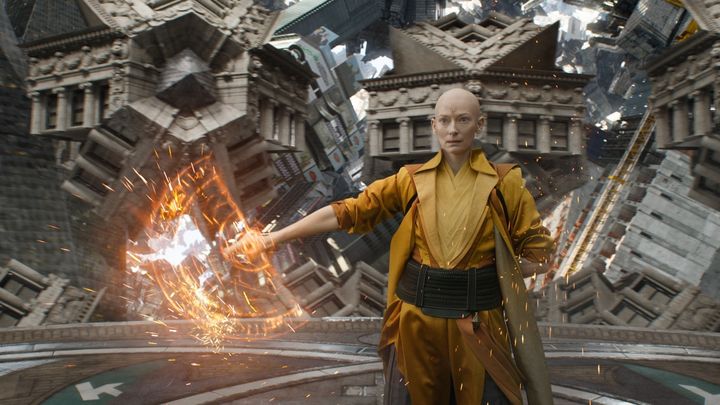
Tilda Swinton in Doctor Strange, motion picture, 2016, Scott Derrickson (director), Stephane Ceretti (visual effects supervisor)
The idea feels so necessary that I trace its presence in my mind back years and years. But this could be an illusion, and I could just now have come upon it, watching these movies. The idea itself can be traced far back in culture, and soon involves the spooky concept of autonomous architecture: the premise that urban aesthetics are so limited and predictable that city buildings can generate themselves by natural processes, like the aesthetically narrow but infinitely diverse universe of snowflakes. Consider the fountain of architecture at the geographical heart of Alex Proyas’s film Dark City (1998), or the endlessly expanding room in Sigizmund Krzhizhanowsky’s short story Quadraturin (1926), or the menacing duplication and rearrangement of classical building elements in Piranesi’s series of prints of imaginary prisons, Carceri d'Invenzione (1750).

Giovanni Battista Piranesi, Carceri Plate VII – The Drawbridge, etching, 1750
The reduction of artificial and intentional artifacts like buildings to the outcome of a monstrously extended organic process – the burgeoning potential of any city to explode into any other city – these are all figments of the imagination. But the imagination, like all living things, comes in several species. One species of imagination creates things entirely new. Another species brings before our eye potential scenarios involving familiar people and objects. The species of imagination related to our impossible buildings and cities is the imagination of superimpositions and transformations. This is the species of imagination which looks at some familiar object and, without losing sight of the nature of the object, sees every other familiar object it could also be.
The art I want to tell you about today has nothing to do with buildings. I start with buildings to explain why this art has such vivid things to say to me. Buildings are the zone in which I have pressing experience of imagination-as-transformation. But many phenomena may show a propensity to spontaneously transform into something else. It is the species of imagination that speaks to me, independent of its subject. I like cities; Zane York likes zoology.
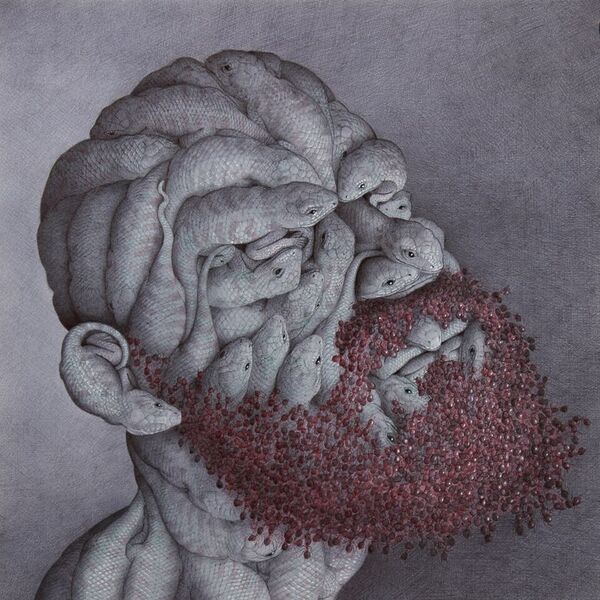
Zane York, Self Portrait/Eastern Fence Lizards and Fire Ants, Ballpoint Pen and Gouache, 12”x12”, 2016
York finds his imagination most fecund when roving over the already-seething terrain of living things. York follows in the footsteps of Arcimboldo, who drew his best inspiration from the vegetable world.

Giuseppe Arcimboldo, Summer, oil on canvas, 1572
York is a member of a small and very old-world sect of imaginative artists who combine an intense naturalism, both in the sense of technique and in the sense of being keen observers of the natural world, with the most bizarre tendency to visualize every organism reconfigured to play the part of another organism. His show Nature Morte, on view at the Arsenal in Central Park until April 27, showcases his recent work in this esoteric realm, a body of paintings in which insects become flowers.
We see in the show the process by which he works up from inspiration to full paintings. In a piece like Asian Long-horned Beetle, he is refining his powers of perception and depiction.
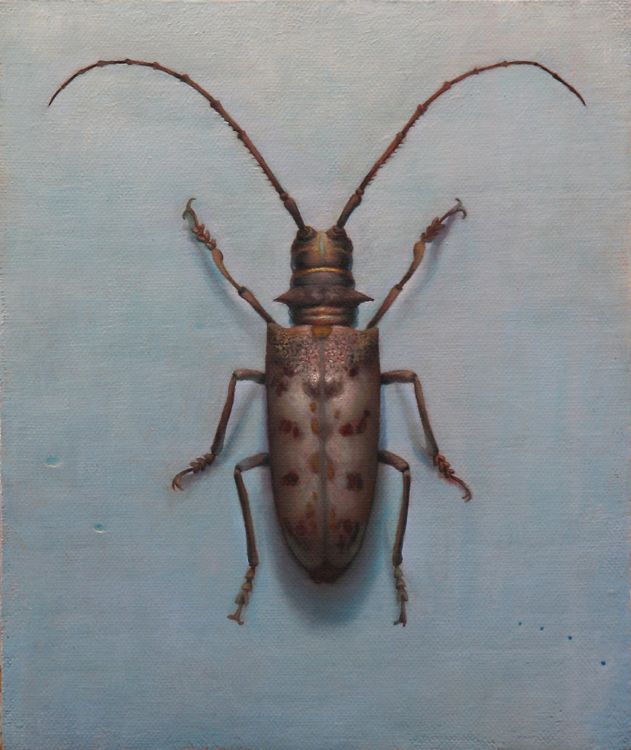
Zane York, Asian Long-horned Beetle, Oil on Canvas mounted to Masonite, 8”x6”, 2008
In Leaf Insect Lily, we see him begin to place his knowledge in service of his fantasy, testing out ideas for how to depict a flower as being composed of insects; matching the geometries of one to the geometries of the other.
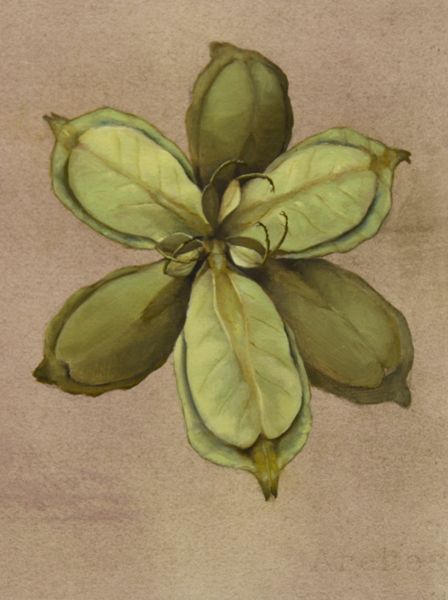
Zane York, Leaf Insect Lily, Oil on Paper, 9.75”x7.25”, 2014
And finally, he compiles his ideas into one of the complete paintings, Arrangement II.
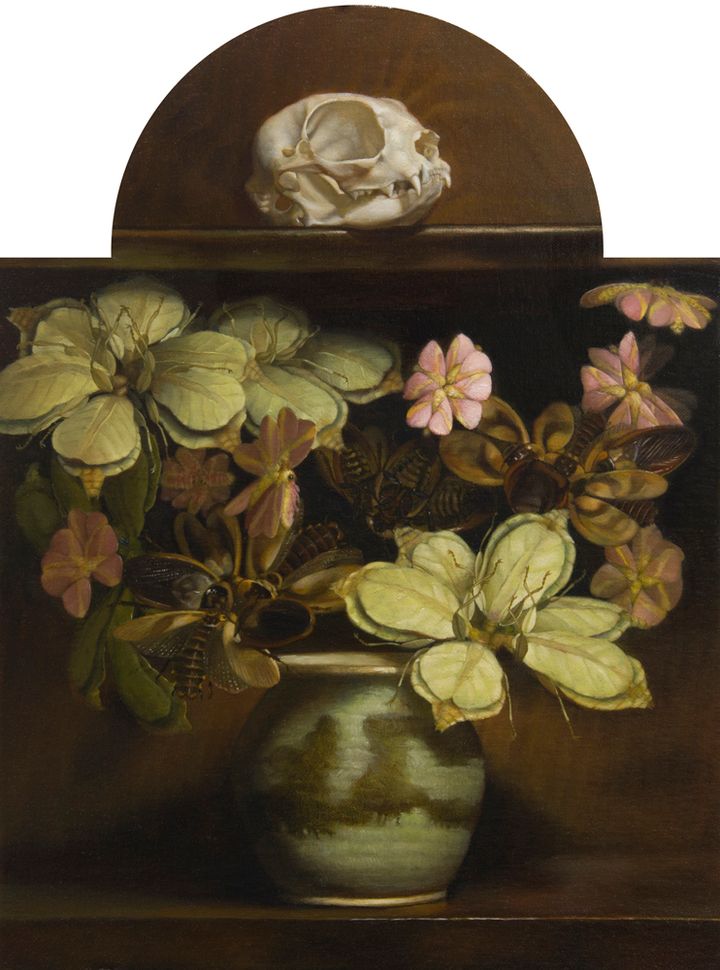
Zane York, Arrangement II, Oil on Canvas mounted to Dibond, 16”x12”, 2016
You see here how he imports the basic design of the leaf insect lily, as well as some other revolting insect/flowers, and displays skills we did not recognize in his studies alone. Integrated into a more ambitious painting, he showcases one of the trickiest of painterly tricks: convincingly unified lighting over a field of colored and curved surfaces rotated at different angles to one another in three-dimensional space. This particular trick, using the steep fall-off and dark shadows of chiaroscuro light, is characteristic of golden age Dutch flower paintings.

Jan Davidszoon de Heem, Vase of Flowers, 1660
York’s insect/flower paintings are compositionally derived from the flower still-lives of the Dutch golden age, down to the dark backgrounds and, in the case of Arrangement II, the inclusion of your basic vanitas skull, although York has swapped out human for cat for good measure. As for the “flowers,” these are based in large part on his imagination – what the Dutch were content to derive closely from reality, York constructs from observation, models, and ultimately, invention.
It cannot be stressed enough that the absurd sophistication of York’s technique is demanded by his subject matter. There is a strong argument to be made for the “deskilling” school of contemporary art. To strip one’s technique down to the most primitive basics, in the context of a supreme spiritual integrity, makes for a thundering expressive language. But like all strategies, it has its costs. Some ideas cannot be expressed in this thick-fingered mode. York brings a surgeon’s precision to his work because his meaning vanishes at any lower resolution.
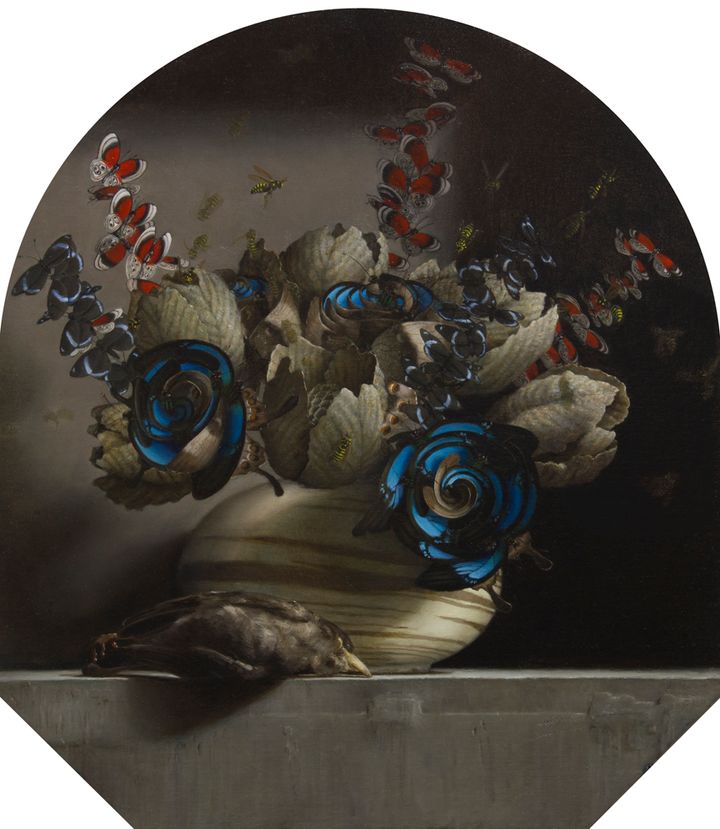
Zane York, Arrangement III, Oil on Canvas mounted to Dibond, 18”x16”, 2016
In Arrangement III, our eye scans and interprets the image before our mind has a chance to object. It is a display of flowers, simple enough. Amid a field of dull blossoms, a few bright blues and rusty reds stand out. The entire thing is beautifully lit, in a soft light which allows a field of highlights and shadows to sigh itself across the scene.
Only a second later do we register that those dull bulbs are bees’ nests, and the blues are impossibly folded butterfly wings, and the reds little butterflies or moths. The stems are absent, because of course these are not flowers. The image shimmers between one nature and another, the mind shrieking at it to stop, to reveal its secrets, to settle down to being what it is. But there is no “what it is” here, there are only different layers of our perception of it, no matter how closely we look. The more we look, the more we realize we are, at last, looking not at a thing but an idea.
This conceptual complexity, sustained by its ability to support looking very closely indeed, modified by its grace notes of unease, disharmony, and illusion, cannot be expressed with less than the technical artillery York brings to bear.
Finally, consider the bewitching Arrangement VI:
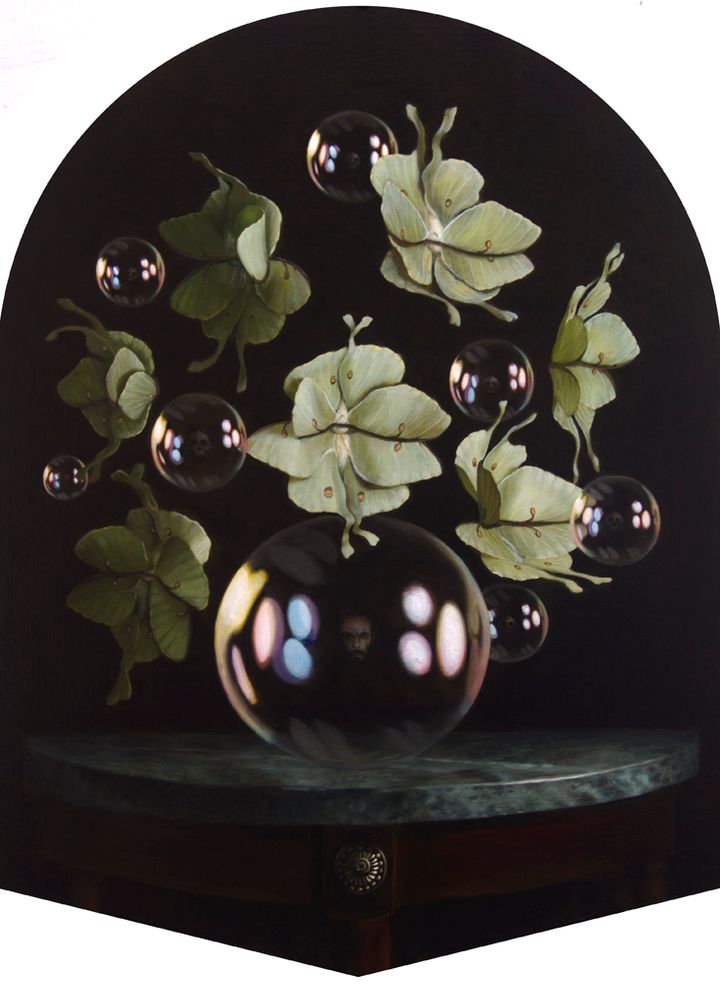
Zane York, Arrangement VI, Oil on Canvas mounted to Dibond, 24”x18”, 2016
In this piece, as in a fading dream, all the elements recur, and yet they have lost even their vestigial connections to one another. The chiaroscuro light remains, and the Dutch notion of how to paint a flower. The flowers are still replaced with confabulations of winged insects. But is this really a bouquet in a vase any longer? The tabletop remains, but the vase has disappeared, and the insect/flowers merely nod to the concept of a bouquet – increasingly, they arrange themselves according to an alien geometry, a hovering mix of flowers and soap bubbles. The vanitas element which comes down from Holland finds expression here as well – each bubble has a faint reflection of the skull of an ape in it, except the big “vase” bubble at the bottom center. That one has a self-portrait of York.
Again, without the refinement and intense application of York’s techniques as a painter, it is possible that the basic idea of this painting could be expressed. But its subtle overtones and nuances would be scoured off. There is such a sense of stillness and clarity in York’s work, of a velvety silence permeated with immanence. The world he invokes is a world bursting with potential, that has already begun rolling down the slope toward an insupportable cascade of transformations. His treatment of this world is not only at the level of the analytic. It is an idiosyncratic treatment, emotional and personal: he somehow imbues it with rich humor and menace. He serves as our Virgil and Beatrice on a journey through a reality hidden just beneath the surface of our agreed-upon reality, leaving us profoundly alienated from our complacency, suddenly sensitive to the possibilities hidden in all those things we got jaded and lazy enough to forget they need not be themselves alone.
---
Zane York, Nature Morte, until April 27
Arsenal in Central Park, 830 Fifth Avenue, Third Floor, Manhattan
